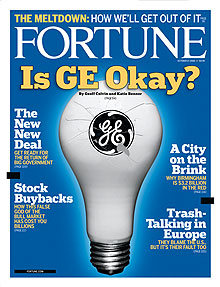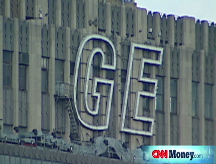GE's $8 billion risk
Things may soon get a lot worse for the economy's bellwether company.
 |
| GE CEO Jeffrey Immelt has asked for no bonus for 2008, in light of the drop in GE's profits and stock price. |
 |
| Last fall, Fortune raised questions about GE's rating and the big cracks that had just begun to show at the GE Capital finance unit. |
NEW YORK (Fortune) -- General Electric may have slashed its dividend to shore up its balance sheet, but a looming ratings downgrade could push it into a cash shortage and funding problems.
If any ratings agency downgrades the credit rating on GE Capital Four notches from its current AAA credit rating below AA- (or AA3 in Moody's rubric), GE Capital could be forced to pay out more than $8 billion immediately, according to its annual report. (See correction.) To put that in context, analysts estimate that all of GE (GE, Fortune 500) will earn about $12 billion in 2009.
"The dividend cut was a move to mitigate the severity of the ratings downgrade," says Nicholas Heymann, an analyst at Sterne Agee who was also a financial analyst and corporate auditor for General Electric more than 20 years ago.
How likely is such a cut? Many analysts who cover the stock believe Moody's will downgrade GE and its finance subsidiary, GE Capital Corp., at the end of this month, but no one is sure how far. S&P has said that if it were to look at GE Capital as a stand alone company, it would only garner an A+ rating. And in late January, Moody's warned that GE was on review for a downgrade. Both are currently AAA rated, the rating bestowed upon the most creditworthy borrowers.
On Friday, Moody's analyst Richard Lane said in a note that GE's dividend cut addresses "some of the concerns regarding the stress on GE's cash flow" but that the agency may still downgrade the company because of deteriorating asset quality and an inability to borrow money.
Deutsche Bank analyst Nigel Coe said in a note that the market has priced in a rating of AA for GE - two notches above the level that GE wants to avoid hitting. Heymann says the company could breach the ratings threshold, even if it doesn't happen this quarter.
After the dividend cut was announced, a GE spokesman declined to comment beyond the company's press release, which said the cut was a move to shore up capital in this tough economic climate. Asked via e-mail about payments triggered by ratings downgrades, a spokesman wrote, "We have said many times we are prepared to run the company should the ratings change but that we will always run the company to be a Triple A."
Arresting the downward spiral at GE Capital is job one to get GE out of the danger zone, says Heymann. In a note released Tuesday, he and Sterne Agee financial analyst Matthew Kelley write: "GE Capital is now confronting the prospect that a downward trend in fundamental performance, fueled by weakening end markets and magnified by severe liquidity constraints, could potentially lead to an extended period of steadily lower earnings, depleted loss provisions, lower credit ratings, rising borrowing costs (and more restricted access to debt markets), potentially tripping capital calls contingent upon various rating thresholds and ultimately the need to seek significant further capital injections, some of which clearly have never been considered or utilized in the past."
So just what happens should GE Capital's rating fall below AA-?
On page 53 of GE's 2008 10k recently filed with the SEC, the company says that at the end of last year, if it had a rating below AA-, GE Capital would have been required to provide about $3.5 billion of capital to support a group of entities that are funded by issuing guaranteed investment contracts (GICs). A GIC provides a fixed return on an amount of capital that the GIC issuer invests.
Another entity at GE Capital also issues GICs and then loans the proceeds back to the finance arm. If GE Capital's rating were to fall below AA-, GE Capital would have to provide about $4.7 billion to repay the GIC holders.
The total $8.2 billion GE would owe could swallow up the $4.2 billion freed up by the recent dividend cut as well as further weaken the company's cash holdings. In an environment where it's difficult to raise cash, that would put GE at risk of further ratings cuts - and more ratings cuts would cost the company even more money.
GICs can burn GE in another way. Should the liabilities in the GICs exceed their fair market value, GE Capital would have to provide the difference. As long as GE is not forced to sell these contracts, this should not be a problem. But had the company sold the GICs at the end of 2008, according to the annual report, the fair value of their assets were only $9.2 billion and the liabilities totaled $10.7 billion, which would make a loss of about $1.5 billion.
GE's annual report also says that if the rating on GE, or applicable entities, falls below A-, then covenants will be triggered on its swap, forward and options contracts that force the company to pay money to its counterparties to account for the additional risk. The fair value of this risk was about $4 billion at the end of 2008, according to page 52 of the 10k.
A cut to its short-term debt rating would also be a blow to GE. Should GE's short-term debt ratings fall below below A-1 (Standard & Poor's) or P-1 (Moody's Rating Service, then it would no longer be eligible to participate in the Federal Reserve's Commercial Paper Funding Facility program.
GE currently has $60 billion in commercial paper outstanding, i.e. short-term loans that roll over every month or so. It is essential that these loans roll over - meaning that lenders continue to let GE borrow on a short-term basis - because these loans fund the company's daily operations.
GE is retiring as much of this debt as it can, and borrowers are rolling over loans because the government is backing them. And even if GE should lose access to government support, few credit market participants believe lenders would stop giving GE short-term loans.
The market seems to think that GE will soon start hemorrhaging cash. The stock, which has fallen about 80% over the past year, is at a 17-year low, trading below $8 a share.
Credit default swaps, which are like insurance contracts that protect against a bond default, have grown increasingly expensive. In order to obtain insurance against $10 million worth of GE Capital bonds, you must pay about $500,000 a year, plus about $975,000 up front. At these prices, the bonds are considered highly distressed.
Analysts say GE has lost credibility with investors who once thought of the stock as a safe haven. In the last year alone it has sprung weaker-than-expected earnings on the market, raised emergency cash from Warren Buffett, and insisted that it had no funding problems - then applied for help from the Fed's commercial paper program and the FDIC's Temporary Liquidity program.
It has also cut its dividend. In its January 23 earnings statement, CEO Jeff Immelt said "The first quarter dividend is done, and we are committed to our plan for $1.24 per share for the year." In a conversation with Wall Street Journal editor Alan Murray on February 5, Immelt discussed why it was important for GE to not slash its dividend. The company issued its dividend on February 6, but said it would re-evaluate the dividend for the second half of 2009. 21 days later, GE cut its dividend by 68%.
So now that a ratings action looms and the company has made clear in its annual report what is riding on a downgrade, why not try to pre-emptively raise cash?
"Devil's advocates have asked us why not just do the capital raise, put the money away for a rainy day, and get the concerns off the table?" wrote Credit Suisse analyst Nicole Parent in a note issued Friday. "Given where we are today, it's interesting food for thought at the very least."
Correction: In an earlier version of this story, we wrote that the company's rating would have to fall three notches to AA- to trigger payments to support guaranteed investment contracts. In fact, the rating would have to fall below AA-, so at least four notches. ![]()
-
 The retail giant tops the Fortune 500 for the second year in a row. Who else made the list? More
The retail giant tops the Fortune 500 for the second year in a row. Who else made the list? More -
 This group of companies is all about social networking to connect with their customers. More
This group of companies is all about social networking to connect with their customers. More -
 The fight over the cholesterol medication is keeping a generic version from hitting the market. More
The fight over the cholesterol medication is keeping a generic version from hitting the market. More -
 Bin Laden may be dead, but the terrorist group he led doesn't need his money. More
Bin Laden may be dead, but the terrorist group he led doesn't need his money. More -
 U.S. real estate might be a mess, but in other parts of the world, home prices are jumping. More
U.S. real estate might be a mess, but in other parts of the world, home prices are jumping. More -
 Libya's output is a fraction of global production, but it's crucial to the nation's economy. More
Libya's output is a fraction of global production, but it's crucial to the nation's economy. More -
 Once rates start to rise, things could get ugly fast for our neighbors to the north. More
Once rates start to rise, things could get ugly fast for our neighbors to the north. More








